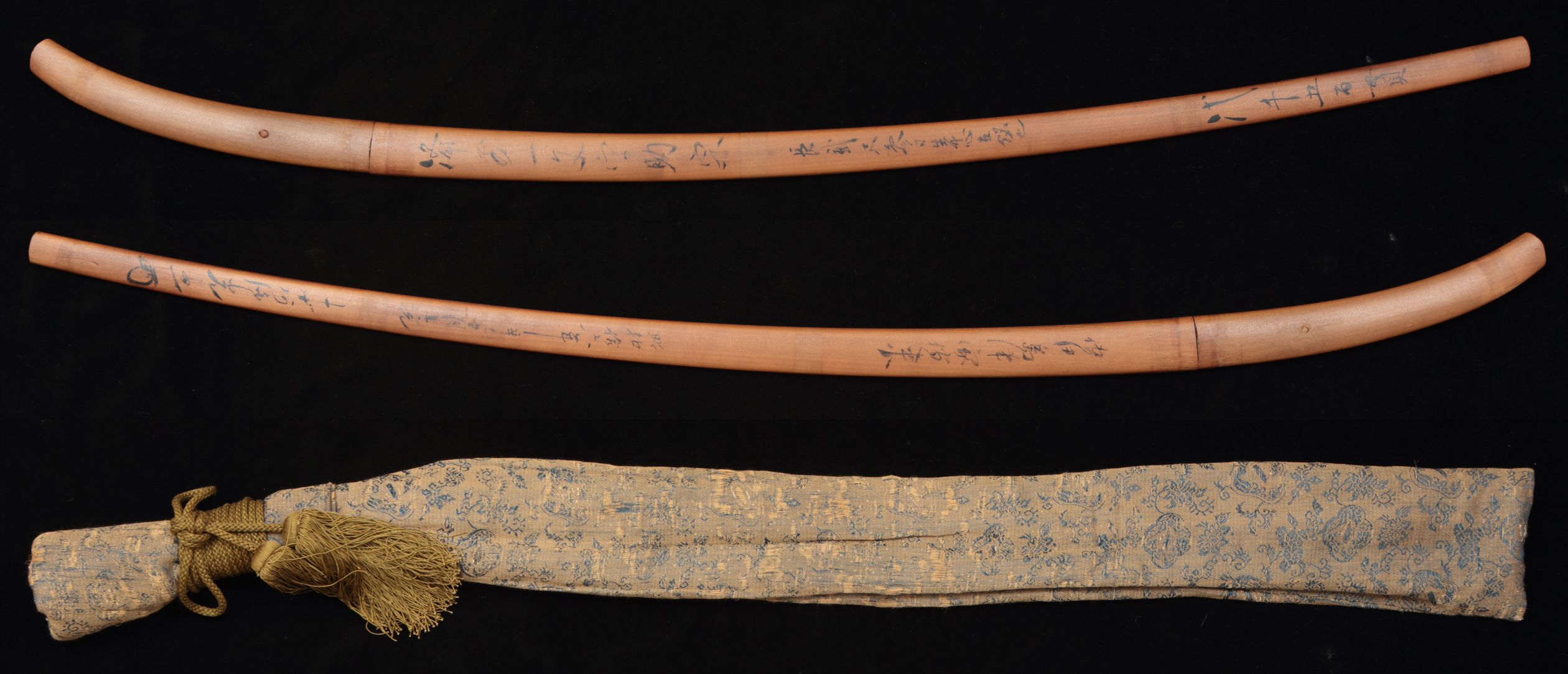[ Feature ]
Form : Shinogi-zukuri. Iori-mune. High koshi-zori attached. There are differences between moto-haba and saki-haba, funbari attached. Finished in ko-kissaki form.
Nakago : Ubu. Yasurimes are kiri. Saki is kiri. Three holes.
Jigane : Ko-itame, mokume mixed. Jinie attached. Partly midare-utsuri is in tatsu state.
Hamon : In sugu-ha tone. Ko-midare and shallow notarebas mixed. Ko-ashis appeared. Ko-nie attached. Yaki-otoshi observed.
Boushi : It runs in shallow notare. Saki is komaru. It tunrs a little.
Writing on saya saya-gaki "鞘書" omote "表" : "備前一文字助宗 長弐尺参寸生中心在銘也" ura "裏" : "代千五百貫 □□︎島津家□来 昭和拾六年辛巳皐月上浣 本阿弥光遜(花押)"
omote : Bizen Ichimon-ji Sukemune nagasa ni-shaku san-sun ubu nakago zai-mei nari
ura : Dai sen-gohyakkan □︎□︎Shimazu-ke □︎rai Showa jyûroku nen kanoto-mi satsuki jyô-kan Hon-ami Kôson (kaô)
Sukemune was a swordsmith who worked around Kougen "康元"(1256~). He was a child of Norimune. He deserved as rota swordsmith of Gotoba-in in September. There are a few swords which have mei singnature. The tachis(*) of Matsugasaki jinjya shrione at Yonezawa city, Yamagata prefecture and Tokyo National Museum are famous. Called "大一文字", elder ichimonji literally, he was good at gorgeous ô-chô-jimidare haon. In the swords which attributed to Sukemue, such swords can be observed. However, the swords with Sukemunes' signature, it tends to have hamon in ko-midare ko-chô-ji mixed.
The tachi with signature Sukemune which designated as jyû-yô-tôken important sword in Heisei 10(2008), has been preserved as shrine's treasure at Izuo Hachiman jinjya shrine in Nara prefecture. Nakago of Izuo Hachiman jinjya shrine tachi and newly presented tachi in this page have similar shape.
The book titled "皇室・将軍家・大名家刀剣目録", (Kô-shitsu the Imperial Family Household, shô-gun families and daimyô Japanese feudral lords swords catalog) by FUKUNAGA Suiken, Yûzankaku, the tachi sword Sukemune, an heirloom of Shimazu family, has the length 70.4cm long. 6th stroke of Chinese character "助" in the signature, the tachis of Matsugasaki jinjya shrione at Yonezawa city, Yamagata prefecture and Tokyo National Museum, are both angular. This sword signature is tinged with roundenss. It has same characteristic, including the tachi of Izuo Hachiman shrine's, all four tachis, the signature are placed haki-omote side above mekugi-ana hole a little mune direction.
In Nihon-tô meikan "日本刀銘鑑", Sukemune in Kamakura period exist in Bizen only. Back to Heian period, Yamashiro Sanjyô Ko-kaji Sukemune around Heiji "平治" ( 1159~ ) mentioned.
Referenced materials : "皇室・将軍家・大名家刀剣目録", FUKUNAGA Suiken, Yû-zankaku, Heisei 9(1997), "日本の美術", HIROI Yû-ichi, Vol. 73, Shibun-dô, Shôwa 47(1972), "後鳥羽院番鍛治考", SATÔ Kanzan, Gotoba-in Ban-kaji kenshô iinkai, Shôwa 49(1974), "日本刀銘鑑" , ISHII Masakuni, HONMA Kunzan, Yûzankaku
[ Highlight ] High koshi-zori. A really old tachi.
[ Conditions ] Yokote-ue of kissaki haki-omote, and shinogi-suji around monouchi, there are shallow kuchi-komi ato traces. Hamon has a part tend to show kake-dashi.





